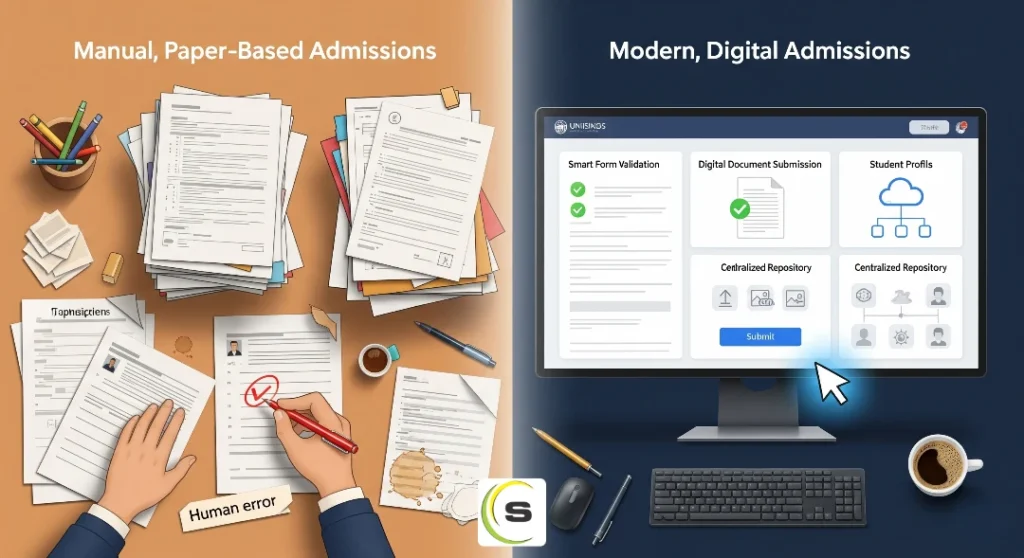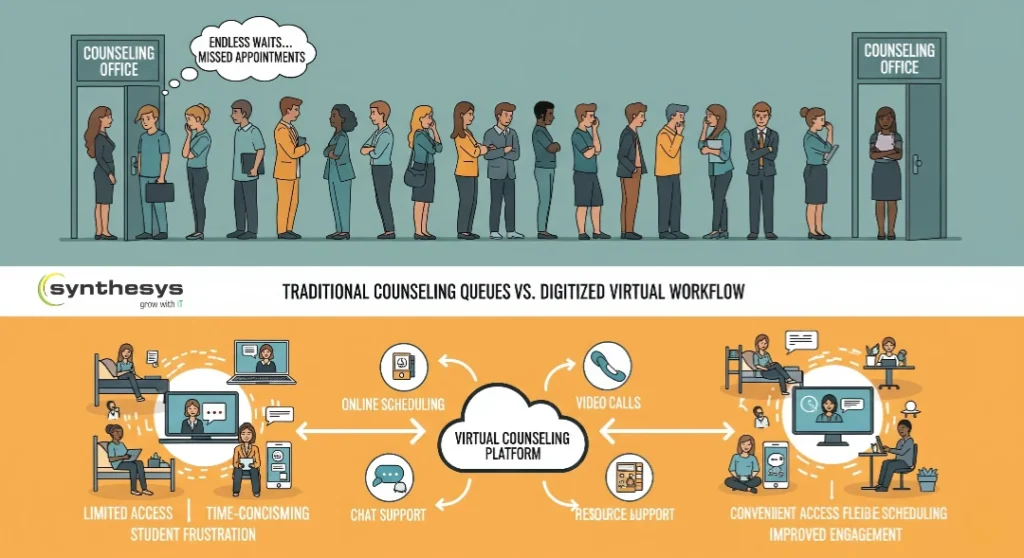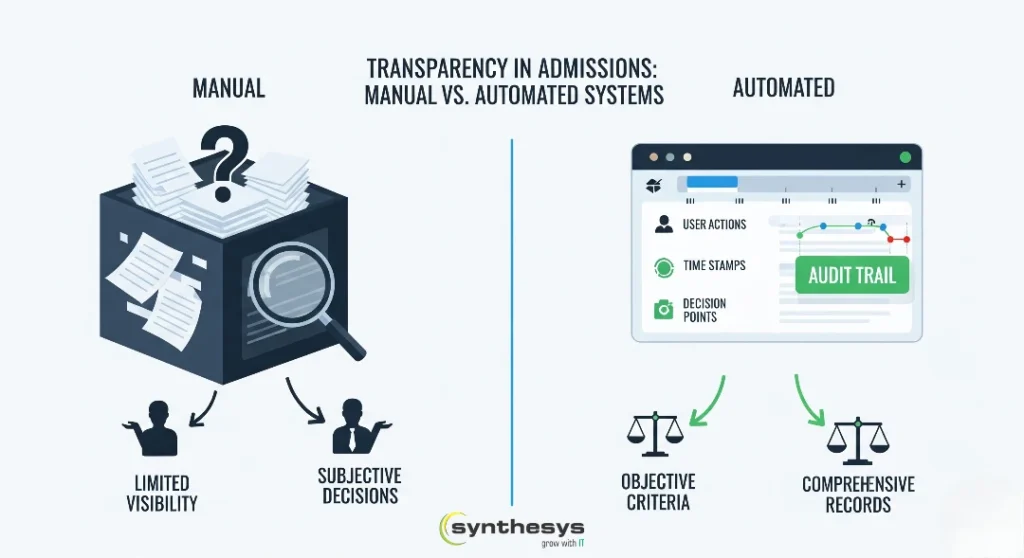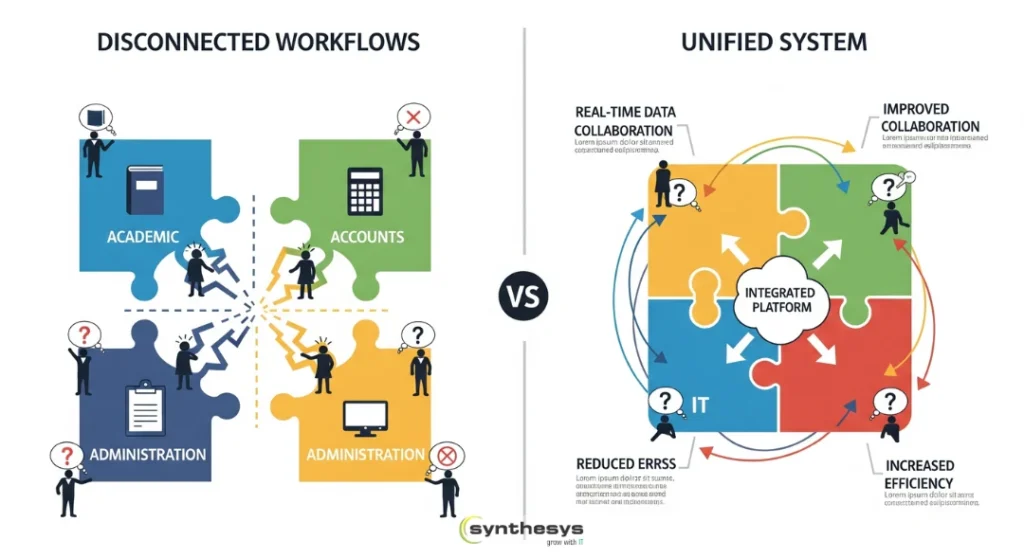Manual Admissions Are Holding Institutions Back
Every year, schools, colleges, universities, and government education departments gear up for what should be a structured, impactful admission season. But in reality, many still rely on manual workflows paper-based applications, spreadsheet tracking, physical verification, and in-person counseling. These methods not only delay processes but strain resources, frustrate applicants, and make it difficult to meet growing expectations for transparency, accessibility, and efficiency.
If you’re a school administrator, a college principal, a government education officer, or someone overseeing the admission lifecycle, it’s time to re-evaluate:
Are manual processes creating more problems than they solve?
In this blog, we break down the five most common pain points of manual admission processes and show how modern digital systems can solve them without overhauling your entire institution overnight.
Pain Point #1: Overwhelming Paperwork & Human Error

The Problem:
Admissions mean forms lots of them. Application forms, ID copies, income and caste certificates, mark sheets, affidavit declarations… the list goes on. Collecting and sorting these manually leads to:
- Missing or duplicate forms
- Data entry errors in names, grades, or categories
- Mismatched documents
- Overloaded staff during peak admission windows
Even a small typo can result in a student’s rejection, legal complaints, or delays that affect the academic calendar.
The Solution:
A digital admission portal allows students to upload scanned documents, auto-fill forms based on Aadhaar/DigiLocker integration, and reduce manual data entry. Built-in validation checks reduce errors before submission.
✔ Smart form validation
✔ Digital document submission
✔ Auto-generated application numbers
✔ Centralized document repository for easy retrieval
Pain Point #2: Long Queues & Delayed Counselling

The Problem:
Students are often asked to appear in person for counseling or document verification even when they’ve traveled from other cities. In many institutions, this results in:
- Long queues outside admission counters
- Missed opportunities for students unable to attend in person
- Stress for admin teams dealing with last-minute submissions
This is particularly problematic in post-pandemic environments or in institutions catering to rural students with travel constraints.
The Solution:
Digitize your pre-admission and counseling workflows. Let students:
- Register and choose programs online
- Schedule virtual counseling slots
- Upload required documents for remote review
- Get notifications on merit lists or waitlist changes
Some institutions also offer hybrid support online forms with in-person help desks or community kiosks.
✔ No more physical queues
✔ Improved access for rural/remote students
✔ Real-time merit list updates
Pain Point #3: Lack of Transparency & Compliance

The Problem:
Manual systems make it difficult to track how selections were made. Education boards, colleges, and universities face challenges like:
- No traceability of who reviewed or approved forms
- Difficulty defending reservation or quota decisions
- Risk of favoritism or selection disputes
- Incomplete data for audits and RTI requests
This weakens public trust especially for government-run or aided institutions.
The Solution:
An automated admission system comes with audit trails, role-based logins, and real-time tracking of every action taken on an application.
✔ Timestamped records of edits and approvals
✔ Transparent rule-based merit list generation
✔ Reports that align with NEP, RTI, and NAAC/NIRF requirements
✔ Easy dashboard access for education officers and auditors
Pain Point #4: Poor Communication with Students

The Problem:
Manual systems rely heavily on notice boards, word of mouth, or phone calls to update students. This results in:
- Missed deadlines
- Duplicate applications
- Last-minute crowding
- Misunderstandings about program selection or required documents
For first-generation learners or those without local guidance, this becomes a major barrier to successful enrollment.
The Solution:
Use automated communication tools within a digital admission system to:
- Send SMS/email alerts on application status
- Share merit list updates in real-time
- Provide online help or live chat support
- Maintain a public FAQ and knowledge base
✔ Keep students informed without manual follow-up
✔ Reduce stress and confusion for parents
✔ Improve perception of your institution’s responsiveness
Pain Point #5: Disconnected Workflows Across Departments

The Problem:
Even if forms are submitted manually, admissions involve multiple departments academic, accounts, administration, and IT. With no unified platform:
- Admission, fee collection, and enrollment data don’t sync
- Multiple teams handle the same student info differently
- Students have to submit the same documents again and again
- Reporting becomes time-consuming and error-prone
The Solution:
Opt for an integrated system that connects admission workflows to:
- Academic course management
- Fee payment systems
- Student record management (SIS/ERP)
- Hostel or transport modules (if needed)
This ensures a single source of truth, improves student experience, and enables smoother transitions to academic registration or exams.
✔ Integrated systems across teams
✔ Avoids repetitive data entry
✔ Improves operational coordination
Real-World Example: Before vs After Digital Admissions
| Task | Manual Process | Digital Process |
| Form Distribution | Printed & limited | Online & unlimited |
| Submission Window | In-person only | 24×7 access |
| Document Check | Physical, slow | Auto-validation |
| Merit List Creation | Manual spreadsheet | System-generated |
| Communication | Phone & notice boards | Email/SMS alerts |
| Audit Reports | Manual file search | 1-click downloads |
Addressing Common Misconceptions
“We’re too small to need an admission system.”
Even smaller institutions benefit from automation. Start with core modules like form submission and fee collection you can scale up later.
“Our staff won’t adapt to new tech.”
Modern portals are user-friendly and come with training. Also, fewer manual tasks mean less pressure during admission seasons.
“Students in rural areas can’t access online forms.”
Most systems today are mobile-first and multi-language, and local help centers or kiosks bridge digital access gaps.
Summary: 5 Problems You Can Eliminate Right Now
Let’s recap what’s holding back your institution and what you can solve with a digital admission system:
Paper overload & manual errors → Smart online forms & validation
In-person queues → Remote application & virtual counseling
Opaque decisions → Transparent, rule-based merit workflows
Poor communication → Automated alerts and status updates
Siloed teams → Integrated, centralized workflows
Turning Challenges Into Opportunities With the Right Digital Partner
The good news is that these admission challenges are solvable and increasingly, institutions across India are adopting digital workflows that match their unique needs.
At Synthesys, we’ve worked with schools, colleges, universities, and examination boards to design and implement custom digital admission systems built specifically for public sector and education environments.
Here’s what we help institutions achieve:
✔ Custom portals tailored to their admission process
✔ Seamless integration with ERP, payment gateways, and government APIs
✔ Mobile-responsive, multi-language access for wider reach
✔ Role-based dashboards for admission teams and decision-makers
✔ Secure, audit-friendly data handling that meets regulatory norms
Whether you’re digitizing admissions for the first time or scaling up an existing system, our team ensures the transition is smooth, compliant, and designed for long-term value.
Need expert support for simplifying your admission process?
Let’s explore how a well-designed system can help your institution deliver faster, more transparent, and student-friendly admissions.
Talk to Synthesys we’d be glad to help.
